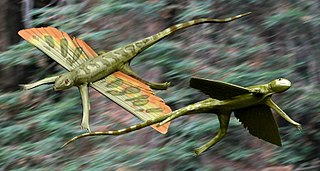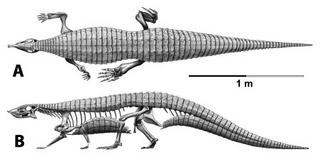 W
WAgnosphitys is a genus of silesaurid dinosauriform that lived during the Late Triassic. It contains only one species, the type species A. cromhallensis. Its remains include an ilium, maxilla, astragalus and humerus, which date variously from the Norian and Rhaetian stages of the Late Triassic, or possibly as late as the Hettangian stage of the Early Jurassic. The fissure fill at Avon, of which Agnosphitys was probably recovered from, was a sinkhole formed by the dissolution of Lower Carboniferous limestones.
 W
WOne of the classic locations for the study of Triassic sandstones in the UK is at Alderley Edge in Cheshire. Numerous scientists from the early 19th century up to the present day have studied the area and it is a popular field site for universities around the UK.
 W
WAsylosaurus is a genus of basal sauropodomorph dinosaur from the Late Triassic of England. It is based on partial remains, described in 1836 by Henry Riley and Samuel Stutchbury as pertaining to Thecodontosaurus, that Othniel Charles Marsh brought to Yale University between 1888 and 1890. These remains thus escaped destruction by a bombardment in 1940 during World War II, unlike the original holotype of Thecodontosaurus. Asylosaurus was described in 2007 by Peter Galton. The type species is A. yalensis, referring to Yale. The bones originally came from a Rhaetian-age cave fill at Durdham Down, Clifton, Bristol.
 W
WAtychodracon is an extinct genus of rhomaleosaurid plesiosaurian known from the Late Triassic - Early Jurassic boundary of England. It contains a single species, Atychodracon megacephalus, named in 1846 originally as a species of Plesiosaurus. The holotype of "P." megacephalus was destroyed during a World War II air raid in 1940 and was later replaced with a neotype. The species had a very unstable taxonomic history, being referred to four different genera by various authors until a new genus name was created for it in 2015. Apart from the destroyed holotype and its three partial casts, a neotype and two additional individuals are currently referred to Atychodracon megacephalus, making it a relatively well represented rhomaleosaurid.
 W
WThe Bromsgrove Sandstone is a geologic formation of the Sherwood Sandstone Group in England. It preserves fossils and ichnofossils of Chirotherium barthii, and Chirotherium sickleri, dating back to the Middle Triassic (Anisian) period.
 W
WThe Keuper Waterstones is a geologic formation in England. It preserves ichnofossils of Varanopus aff. curvidactylus, Swinnertonichnus mapperleyensis, Deuterotetrapous plancus, Chirotherium swinnertoni, Microsauropus acutipes and Erpetopus willistoni dating back to the Middle Triassic (Anisian) period.
 W
WKuehneosaurus is an extinct genus of Late Triassic kuehneosaurid reptile known from the Late Triassic of Luxembourg. It was named by P. L. Robinson in 1962 and the type and only species is Kuehneosaurus latus. Measuring 72 centimetres long, it had "wings" formed from ribs which jutted out from its body by as much as 14.3 cm, connected by a membrane which allowed it to slow its descent when jumping from trees. It is a member of a family of gliding reptiles, the Kuehneosauridae, within the larger group Lepidosauromorpha, which also contains modern lizards and tuatara.
 W
WKuehneosuchus is an extinct genus of Late Triassic kuehneosaurid reptile known from the Late Triassic of southwest England. It was named by P. L. Robinson in 1967 and the type and only species is Kuehneosuchus latissimus. It is known from the holotype NHMUK PV R 6111, a set of associated vertebrae and ribs. It is a derived kuehneosaurid, most closely related to Kuehneosaurus. The genera are very similar and can be distinguished from one another primarily on the length of their "wing" ribs, relatively short and massive in Kuehneosaurus but up to 4 times longer and more gracile in Kuehneosuchus. However, the skull and major postcranial bones are identical in both taxa, as their age and horizon. According to aerodynamic studies Kuehneosuchus, unlike Kuehneosaurus which may be a species of the same genus or represent a different sexual morph, was probably a glider.
 W
WThe Lilstock Formation is a geologic formation in England. It preserves bivalve, insect and other invertebrate fossils, as well as fossil fish of Agkistracanthus mitgelensis and the basal theropod dinosaur "Zanclodon" cambrensis dating back to the Rhaetian of the Triassic period.
 W
WThe Magnesian Conglomerate is a geological formation in Clifton, Bristol in England. It dates back to the Rhaetian stage of the Late Triassic. This formation was first studied in 1836 by Henry Riley and Samuel Stutchbury.
 W
WThe Scunthorpe Mudstone is a geologic formation in England. It preserves plesiosaur fossils dating back to the Late Triassic (Rhaetian) to Early Jurassic (Hettangian) period. It predominantly consists of grey mudstone with thin beds of argillaceous limestone and calcareous siltstone. The Ichthyosaur Wahlisaurus is known from the formation. As is the holotype specimen of the dinosaur Sarcosaurus.
 W
WThe Sherwood Sandstone Group is a Triassic lithostratigraphic group which is widespread in Britain, especially in the English Midlands. The name is derived from Sherwood Forest in Nottinghamshire which is underlain by rocks of this age. It has economic importance as the reservoir of the Morecambe Bay gas field, the second largest gas field in the UK.
 W
WStagonolepis is an extinct genus of stagonolepidid aetosaur known from the Late Triassic Hassberge Formation of Germany, the Drawno Beds of Poland, the Lossiemouth Sandstone of Scotland, the Chinle Formation of Arizona and Utah and the Bluewater Creek Formation of New Mexico.
 W
WTerrestrisuchus is an extinct genus of very small early crocodylomorph that was about 76 centimetres (30 in) long. Fossils have been found in Wales and Southern England and date from near the very end of the Late Triassic during the Rhaetian, and it is known by type and only known species T. gracilis. Terrestrisuchus was a long-legged, active predator that lived entirely on land, unlike modern crocodilians. It inhabited a chain of tropical, low-lying islands that made up southern Britain, along with similarly small-sized dinosaurs and abundant rhynchocephalians. Numerous fossils of Terrestrisuchus are known from fissures in limestone karst which made up the islands it lived on, which formed caverns and sinkholes that preserved the remains of Terrestrisuchus and other island-living reptiles.
 W
WThecodontosaurus is a genus of herbivorous basal sauropodomorph dinosaur that lived during the late Triassic period.
 W
WThe Westbury Shales is a geologic formation in England. It preserves fossils of Holcoptera schlotheimi, Saurichthys acuminatus, Coleopteron sp. and Liassophlebia sp. dating back to the Rhaetian period.